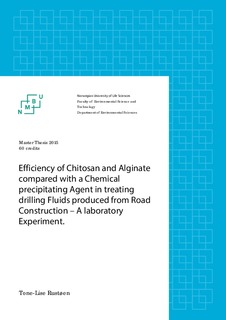| dc.description.abstract | Water used by different machines in the road construction phase, has to be purified in accordance with limitations in the discharge permit, set by the county governor. One of the main parameters set in this permit is suspended solids. Fluctuations in particle load, and also shifts in pH, can vary from day to day during the construction process. Overdosing of inorganic precipitating agents is therefore a common problem, as small variations in inlet water can change the required dose.This can result in an excess of coagulants in outlet water, and in the case of inorganic precipitating agents, this can be harmful for the aquatic environment.
Naturally occurring organic polymers may be a better alternative to inorganic coagulants in treating water used in construction processes. Thus, the cationic polymer chitosan – extracted from crustaceans, and the anionic polymer alginate – extracted from brown seaweed, could replace the inorganic precipitating agents currently used in water treatment.
This thesis researches the effectiveness of two types of both chitosan and alginate, compared to ferric chloride sulfate (PIX-318), tested on drilling fluid produced from bridge construction conducted at Knappstad, Norway. The discharge permit with regards to suspended solids at this project is a weekly average of 500 mg/L.
The performance of precipitating agents was researched in both undiluted (>6000 NTU) and diluted (4000, 3000, 2000, 1000 NTU) drilling fluid that held 21 ± 1 °C. Experiments were conducted with the use of standardized jar- test equipment (Kemira AB Flocculator 2000), and turbidity measurements with the use of a laboratory turbidity meter (Model 2100AN IS, Hath Company).
Residual turbidity <500 NTU was successfully obtained using both chitosan types in undiluted and diluted drilling fluid, whereas the same residual turbidity was not obtained using either types of alginate. The dose of PIX-318 required to achieve the same turbidity removal efficiency as chitosan, was almost 20 times lower in undiluted drilling fluid. Chitosan would be effective as a primary precipitating agent in treating water from piling under the conditions presented in this thesis. However, further research and investigation with regards to large scale use as well as the economic and environmental aspects has to be conducted before it can be recommended. | nb_NO |
